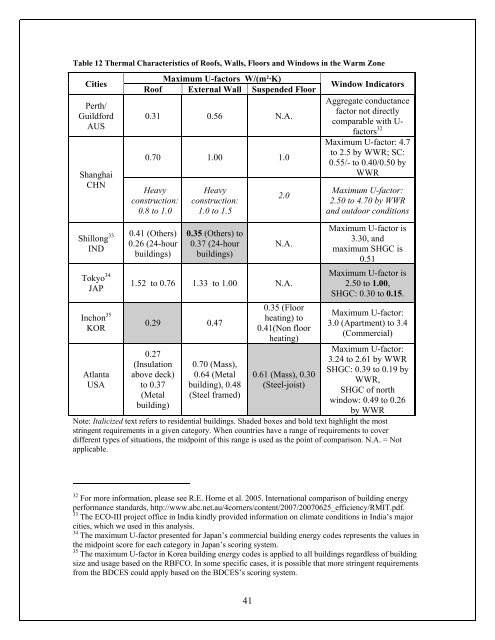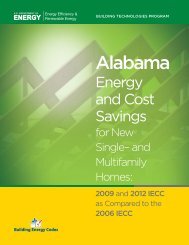Shaping the Energy Efficiency in New Buildings - Building Energy ...
Shaping the Energy Efficiency in New Buildings - Building Energy ...
Shaping the Energy Efficiency in New Buildings - Building Energy ...
Create successful ePaper yourself
Turn your PDF publications into a flip-book with our unique Google optimized e-Paper software.
Table 12 Thermal Characteristics of Roofs, Walls, Floors and W<strong>in</strong>dows <strong>in</strong> <strong>the</strong> Warm ZoneCitiesPerth/GuildfordAUSShanghaiCHNShillong 33INDTokyo 34JAPInchon 35KORAtlantaUSAMaximum U-factors W/(m²·K)Roof External Wall Suspended Floor0.31 0.56 N.A.0.70 1.00 1.0Heavyconstruction:0.8 to 1.00.41 (O<strong>the</strong>rs)0.26 (24-hourbuild<strong>in</strong>gs)Heavyconstruction:1.0 to 1.50.35 (O<strong>the</strong>rs) to0.37 (24-hourbuild<strong>in</strong>gs)2.0N.A.1.52 to 0.76 1.33 to 1.00 N.A.0.29 0.470.27(Insulationabove deck)to 0.37(Metalbuild<strong>in</strong>g)0.70 (Mass),0.64 (Metalbuild<strong>in</strong>g), 0.48(Steel framed)0.35 (Floorheat<strong>in</strong>g) to0.41(Non floorheat<strong>in</strong>g)0.61 (Mass), 0.30(Steel-joist)W<strong>in</strong>dow IndicatorsAggregate conductancefactor not directlycomparable with U-factors 32Maximum U-factor: 4.7to 2.5 by WWR; SC:0.55/- to 0.40/0.50 byWWRMaximum U-factor:2.50 to 4.70 by WWRand outdoor conditionsMaximum U-factor is3.30, andmaximum SHGC is0.51Maximum U-factor is2.50 to 1.00,SHGC: 0.30 to 0.15.Maximum U-factor:3.0 (Apartment) to 3.4(Commercial)Maximum U-factor:3.24 to 2.61 by WWRSHGC: 0.39 to 0.19 byWWR,SHGC of northw<strong>in</strong>dow: 0.49 to 0.26by WWRNote: Italicized text refers to residential build<strong>in</strong>gs. Shaded boxes and bold text highlight <strong>the</strong> moststr<strong>in</strong>gent requirements <strong>in</strong> a given category. When countries have a range of requirements to coverdifferent types of situations, <strong>the</strong> midpo<strong>in</strong>t of this range is used as <strong>the</strong> po<strong>in</strong>t of comparison. N.A. = Notapplicable.32 For more <strong>in</strong>formation, please see R.E. Horne et al. 2005. International comparison of build<strong>in</strong>g energyperformance standards, http://www.abc.net.au/4corners/content/2007/20070625_efficiency/RMIT.pdf.33 The ECO-III project office <strong>in</strong> India k<strong>in</strong>dly provided <strong>in</strong>formation on climate conditions <strong>in</strong> India’s majorcities, which we used <strong>in</strong> this analysis.34 The maximum U-factor presented for Japan’s commercial build<strong>in</strong>g energy codes represents <strong>the</strong> values <strong>in</strong><strong>the</strong> midpo<strong>in</strong>t score for each category <strong>in</strong> Japan’s scor<strong>in</strong>g system.35 The maximum U-factor <strong>in</strong> Korea build<strong>in</strong>g energy codes is applied to all build<strong>in</strong>gs regardless of build<strong>in</strong>gsize and usage based on <strong>the</strong> RBFCO. In some specific cases, it is possible that more str<strong>in</strong>gent requirementsfrom <strong>the</strong> BDCES could apply based on <strong>the</strong> BDCES’s scor<strong>in</strong>g system.41
















